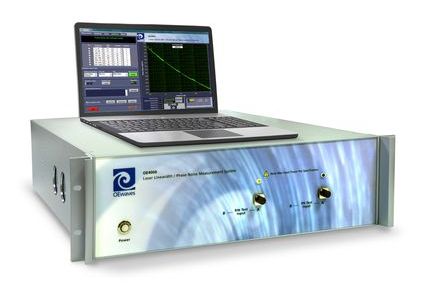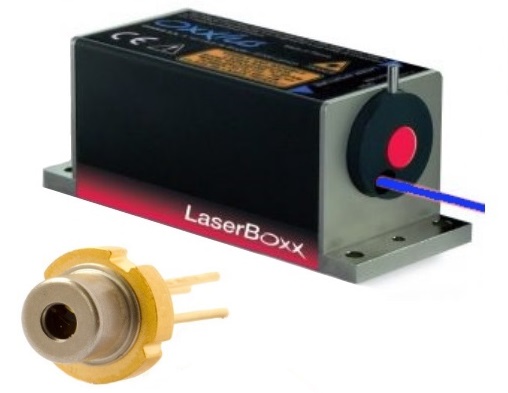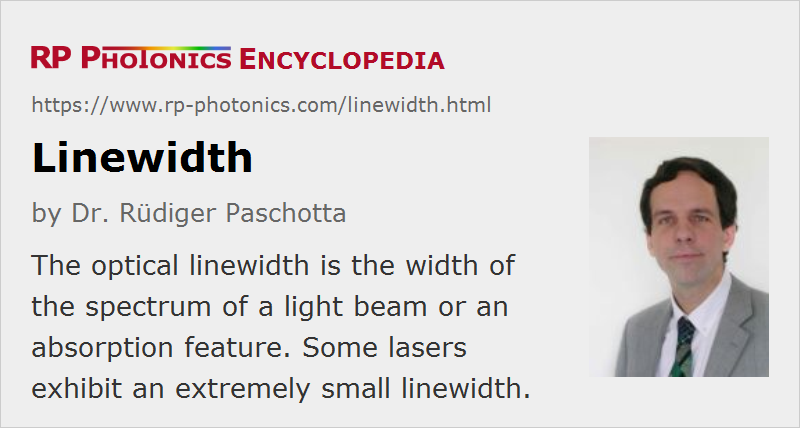Linewidth
Definition: width of the spectrum of a light beam or an absorption feature
Alternative term: emission bandwidth
More specific terms: emission linewidth, laser linewidth, Schawlow–Townes linewidth
German: Linienbreite
Categories: lasers, fluctuations and noise, physical foundations
Formula symbol: Δν, Δλ
Units: Hz, nm
How to cite the article; suggest additional literature
Author: Dr. Rüdiger Paschotta
The linewidth (or line width) of a laser, e.g. a single-frequency laser, is the width (typically the full width at half-maximum, FWHM) of its optical spectrum. More precisely, it is the width of the power spectral density of the emitted electric field in terms of frequency, wavenumber or wavelength.
Similarly, other spectral lines e.g. from gas discharge lamps have certain linewidths, which can depend on the operation conditions.
The linewidth of a light beam is strongly (but non-trivially) related to the temporal coherence, characterized by the coherence time or coherence length. A finite linewidth arises from phase noise if the optical phase undergoes unbounded drifts, as is the case for free-running laser oscillators, for example. (Phase fluctuations which are restricted to a small interval of phase values lead to a zero linewidth and some noise sidebands.) Drifts of the resonator length can further contribute to the linewidth and can make it dependent on the measurement time. This shows that the linewidth alone, or even the linewidth complemented with a spectral shape (line shape), does by far not provide full information on the spectral purity of laser light. (This is particularly the case for lasers with dominating low-frequency phase noise.) More data are required for full noise specifications.
The r.m.s. linewidth can be defined as the root-mean-square value of the instantaneous optical frequency:

where usually some limited integration range for the noise frequencies is chosen. This quantity can be more easily calculated from the power spectral density SΔν(f) of the instantaneous frequency. Note, however, that the r.m.s. linewidth is not always a sensible measure; one should only use it in cases with strongly increasing SΔν(f) for decreasing noise frequency (flicker noise), but not e.g. for white frequency noise. The relation between the r.m.s. linewidth and the width of the optical spectrum is not trivial and depends on the shape of the frequency noise spectrum.
Lasers with very narrow linewidth (high degree of monochromaticity) are required for various applications, e.g. as light sources for various kinds of fiber-optic sensors, for laser spectroscopy (e.g. LIDAR), in coherent optical fiber communications, and for test and measurement purposes. Note that the achieved linewidth can be many orders of magnitude below the line with of the used laser transition.
Quantum Noise and Technical Noise
The simplest situation is one where only spontaneous emission (quantum noise) introduces phase noise. In that case, the noise of the instantaneous frequency is white noise, i.e., its power spectral density is constant, and the emission spectrum is of Lorentzian shape. The corresponding linewidth was calculated by Schawlow and Townes [] even before the first laser was experimentally demonstrated. According to the modified Schawlow–Townes equation (with a correction from M. Lax)
Hear the Phase Noise!
In order to get some feeling for phase noise, you can listen to the following short sound samples of a 440-Hz tone with different linewidths (white phase noise, no amplitude noise):
0 Hz (no noise), 1 Hz, 5 Hz, 10 Hz
You can download these .wav files (each being ≈ 215 KB long) and play them with any sound player software.
For comparison, if you temporally stretch the output of a 1064-nm Nd:YAG laser with a 10-kHz linewidth to 440 Hz, the linewidth will be ≈ 16 nHz – a pretty pure tone indeed!

the linewidth (FWHM) is proportional to the square of the resonator bandwidth divided by the output power (assuming that there are no parasitic resonator losses). The article on the Schawlow–Townes linewidth contains a more practical form of the equation.
The Schawlow–Townes limit is usually difficult to reach in reality, as there are various technical noise sources (e.g. mechanical vibrations, temperature fluctuations, and pump power fluctuations) which are difficult to suppress. There are therefore certain compromises in laser design for narrow linewidth. For example, a long laser resonator leads to a small Schawlow–Townes linewidth, but makes it more difficult to achieve stable single-frequency operation without mode hops, and to get a mechanically stable setup.
Typical measured linewidths of stable free-running single-frequency solid-state lasers (e.g. for a measurement time of 1 s) are a few kilohertz, which is far above the Schawlow–Townes limit. Various sources of technical noise, e.g. fluctuations of the resonator length, the pump power or the temperature of the laser crystal, can be responsible for the increased linewidth.
The linewidths of monolithic semiconductor lasers are often in the megahertz range and are strongly increased above the Schawlow–Townes limit mainly by amplitude-phase coupling, as described with the linewidth enhancement factor. There can also be excess noise from charge carrier fluctuations with a 1 / f characteristic of the PSD of the frequency fluctuations. In that case, the measurement time influences the measured linewidth value.
Much smaller linewidths, sometimes even below 1 Hz, can be reached by stabilization of lasers, e.g. using ultrastable reference cavities. Small linewidths are important, e.g. for spectroscopic measurements and for application in fiber-optic sensors.
Measurement of Laser Linewidth
A laser linewidth can be measured with a variety of techniques:
- For large linewidths (e.g. > 10 GHz, as obtained when multiple modes of the laser resonator are oscillating), traditional techniques of optical spectrum analysis, e.g. based on diffraction gratings, are suitable. A high frequency resolution is difficult to obtain in this way.
- Another technique is to convert frequency fluctuations to intensity fluctuations, using an optical frequency discriminator, which can be, e.g., an unbalanced interferometer or a high-finesse reference cavity. Again, the measurement resolution is quite limited.
- For single-frequency lasers, the self-heterodyne technique is often used, which involves recording a beat note between the laser output and a frequency-shifted and delayed version of it.
- For sub-kilohertz linewidths, the ordinary self-heterodyne technique usually becomes impractical, as one would require a very large delay length, but it can be extended by using a recirculating fiber loop with an internal fiber amplifier.
- Very high resolution can also be obtained by recording a beat note between two independent lasers, where either the reference laser has significantly lower noise than the device under test, or both lasers have similar performance. One can retrieve the instantaneous difference frequency e.g. with PLL (phase-locked loop) following the beat signal, or numerically from digitized recordings. This method is conceptually very simple and reliable, but the requirement of a second laser (operating at a nearby optical frequency) can be inconvenient. If linewidth measurements are required in a wide spectral range, a frequency comb source can be very useful.
Note that an optical frequency measurement always needs some kind of frequency (or timing) reference somewhere in the setup. For lasers with narrow linewidth, only an optical reference can give a sufficiently accurate reference. The self-heterodyne technique is a way to derive the frequency reference from the device under test itself by applying a large enough time delay, ideally avoiding any temporal coherence between the original beam and the delayed version. Therefore, long fibers are often used; however, long fibers tend to introduce additional phase noise due to temperature fluctuations and acoustic influences.
Particularly in cases with 1 / f frequency noise, a linewidth value alone may not be regarded as completely characterizing the phase noise. It may then be better to measure the whole Fourier spectrum of the phase or instantaneous frequency fluctuations and characterize it with a power spectral density; see also the article on noise specifications. Note also that 1 / f frequency noise (or other noise spectra with strong low-frequency noise) can cause problems with some measurement techniques.
Minimization of Laser Linewidth
The linewidth of a laser depends strongly on the type of laser. It may be further minimized by optimizing the laser design and suppressing external noise influences as far as possible. The first step should be to determine whether quantum noise or classical noise is dominating, because the required measures can depend very much on this.
The influence of quantum noise (essentially spontaneous emission noise) is small for a laser with high intracavity power, low resonator losses, and a long resonator round-trip time. Classical noise may be introduced via mechanical fluctuations, which can often be kept weaker for a compact short laser resonator, but note that resonator length fluctuations of a certain magnitude have a stronger effect in a shorter resonator. Proper mechanical construction can minimize the coupling of the laser resonator to external vibrations and also minimize effects of thermal drift. There can also be thermal fluctuations in the gain medium, introduced e.g. by a fluctuating pump power. For superior noise performance, various schemes for active stabilization can be employed, but it is often advisable first to use all practical passive methods.
Single-frequency solid-state bulk and fiber lasers can achieve linewidths of a few kilohertz, or sometimes even below 1 kHz. With serious efforts at active stabilization, sub-hertz linewidths are sometimes achieved. The linewidth of a laser diode is typically in the megahertz region, but it can also be reduced to a few kilohertz, e.g. in external-cavity diode lasers, particularly with optical feedback from a high-finesse reference cavity.
See also the article on narrow-linewidth lasers.
Problems Resulting from a Narrow Linewidth
A narrow linewidth from a laser source is not always desirable:
- A large coherence length implies that interference effects (e.g. due to weak parasitic reflections) can easily spoil the beam profile. In laser projection displays, laser speckle effects can disturb the image quality.
- For transmission of light in passive or active optical fibers, a narrow linewidth can cause problems due to stimulated Brillouin scattering. It is then sometimes necessary to increase the optical linewidth, for example by fast dithering of the instantaneous frequency via current modulation of a laser diode or with an optical modulator.
Linewidth in Other Context
The term linewidth is also used for the width of optical transitions (e.g. a laser transition or some absorption feature). For transitions in single atoms or ions at rest, the linewidth is related to the upper-state lifetime (more precisely, the lifetime of both upper and lower states) (lifetime broadening) and is called natural linewidth. Significant linewidth broadening can be caused by movement of the atoms or ions (→ Doppler broadening) or by interactions, e.g. pressure broadening in gases or interactions with phonons in solid media. If different atoms or ions are subject to different influences, this leads to inhomogeneous broadening.
The linewidth of a transition is often related to a Q factor, which is the frequency divided by the linewidth.
Suppliers
The RP Photonics Buyer's Guide contains 21 suppliers for linewidth measurement equipment. Among them:


OEwaves
OEwaves’ HI-Q™ Optical Test Measurement System utilizes a homodyne methodology for automated measurement capable of testing ultra-low phase noise laser sources. The user friendly test system is capable of rapidly measuring <10 Hz of Lorentzian linewidth of a laser source without the complicated setup typically required to make such a narrow linewidth measurement.
This homodyne based system is unique in wide band measurement without requiring another low noise reference laser source. The complete system operates with ease, speed and precision, and a simple graphic user interface via a PC, without requiring any additional test equipment. The unmatched ultra-low phase/frequency noise analyzer system is scalable to various input wavelengths and capable of low relative intensity noise (RIN) measurement.


RPMC Lasers
RPMC offers a wide range of narrow linewidth laser diodes and laser modules with wavelengths from 405 nm to 2 μm. These offerings include DFB and DBR diode lasers, external cavity VBG diode lasers, fiber lasers, and DPSS lasers. All are available in both OEM and turnkey packages.


TOPTICA Photonics
All of TOPTICA’s tunable diode lasers offer a narrow linewidth of typically 100 kHz, corresponding to coherence lengths of almost 1 km. By stabilizing these lasers even further with TOPTICA’s locking electronics, linewidths below 1 Hz are possible.
Questions and Comments from Users
Here you can submit questions and comments. As far as they get accepted by the author, they will appear above this paragraph together with the author’s answer. The author will decide on acceptance based on certain criteria. Essentially, the issue must be of sufficiently broad interest.
Please do not enter personal data here; we would otherwise delete it soon. (See also our privacy declaration.) If you wish to receive personal feedback or consultancy from the author, please contact him e.g. via e-mail.
By submitting the information, you give your consent to the potential publication of your inputs on our website according to our rules. (If you later retract your consent, we will delete those inputs.) As your inputs are first reviewed by the author, they may be published with some delay.
Bibliography
| [1] | A. L. Schawlow and C. H. Townes, “Infrared and optical masers”, Phys. Rev. 112 (6), 1940 (1958), doi:10.1103/PhysRev.112.1940 (contains the famous Schawlow–Townes equation) |
| [2] | C. H. Henry, “Theory of the linewidth of semiconductor lasers”, IEEE J. Quantum Electron. 18 (2), 259 (1982), doi:10.1109/JQE.1982.1071522 |
| [3] | L. D. Turner et al., “Frequency noise characterization of narrow linewidth diode lasers”, Opt. Commun. 201, 391 (2002), doi:10.1016/S0030-4018(01)01689-3 |
| [4] | G. Di Domenico et al., “Simple approach to the relation between laser frequency noise and laser line shape”, Appl. Opt. 49 (25), 4801 (2010), doi:10.1364/AO.49.004801 |
See also: spectral lines, laser lines, linewidth enhancement factor, optical spectrum analyzers, optical phase, coherence time, coherence length, phase noise, optical frequency, frequency noise, noise specifications, laser specifications, laser noise, single-frequency operation, narrow-linewidth lasers, self-heterodyne linewidth measurement, stabilization of lasers, The Photonics Spotlight 2007-06-24, The Photonics Spotlight 2007-10-11, The Photonics Spotlight 2008-07-26
and other articles in the categories lasers, fluctuations and noise, physical foundations
 |






If you like this page, please share the link with your friends and colleagues, e.g. via social media:
These sharing buttons are implemented in a privacy-friendly way!